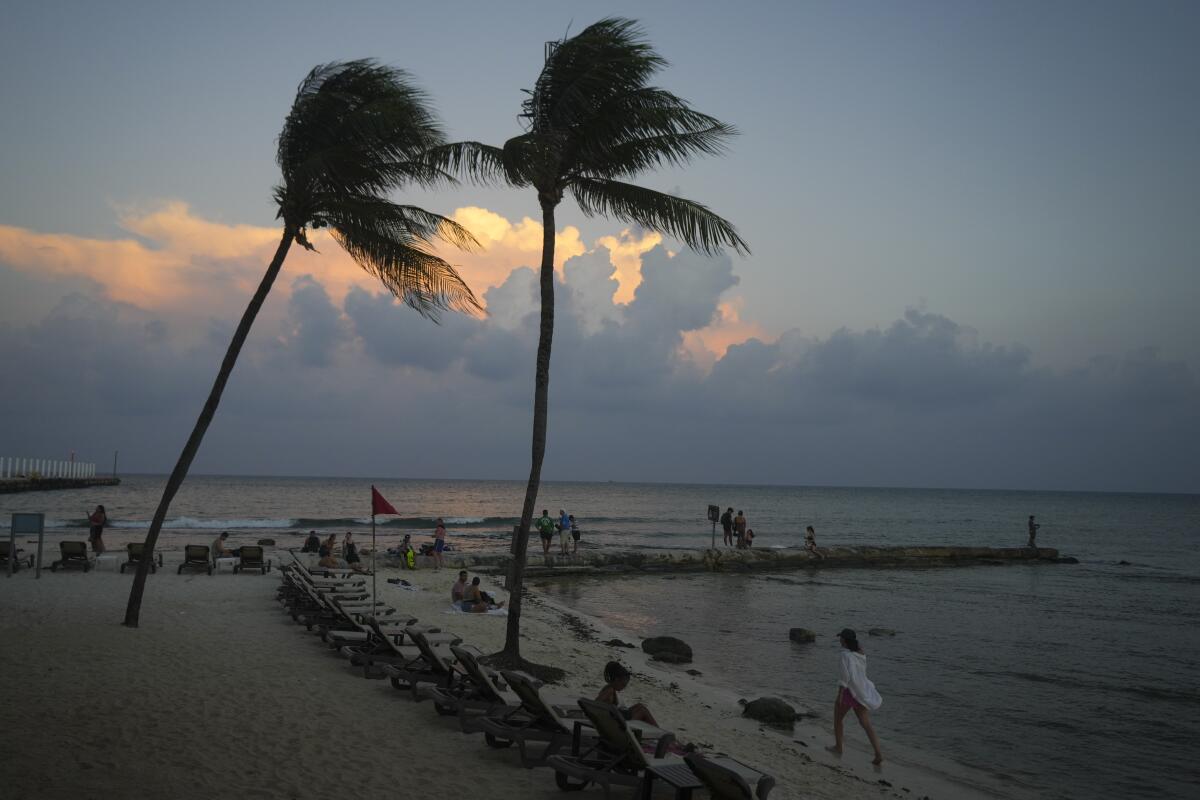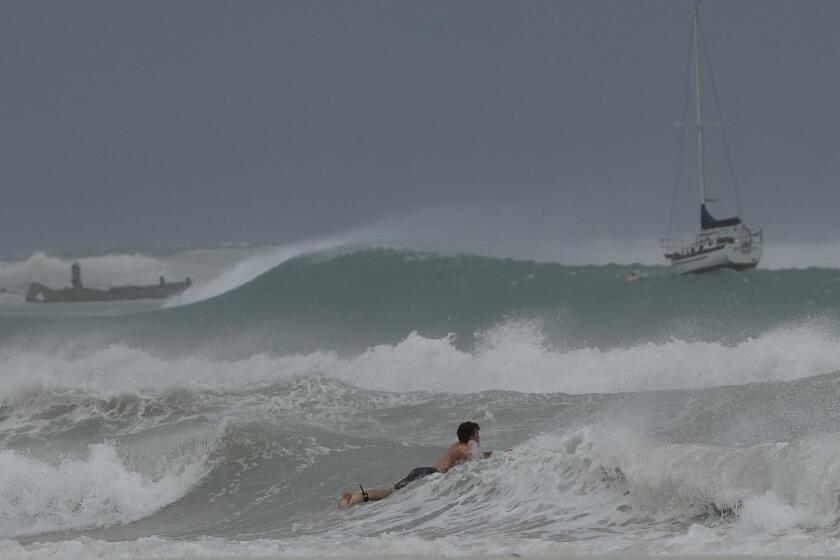Hurricane Beryl churns toward Mexico after leaving destruction in Jamaica and eastern Caribbean

- Share via
TULUM, Mexico — Hurricane Beryl ripped off roofs in Jamaica, jumbled fishing boats in Barbados and damaged or destroyed 95% of homes on two islands in St. Vincent and the Grenadines before rumbling past the Cayman Islands early Thursday and taking aim at Mexico’s Caribbean coast.
What had been the earliest storm to develop into a Category 5 hurricane in the Atlantic, weakened to a Category 2 by Thursday afternoon. The storm had by then killed at least nine people, according to authorities.
Jack Beven, senior hurricane specialist at the U.S. Hurricane Center, said “the biggest immediate threat now that the storm is moving away from the Cayman Islands is landfall in the Yucatan Peninsula” in Mexico.
The storm’s center was about 135 miles west of Grand Cayman island and 275 miles east-southeast of Tulum, Mexico. It had maximum sustained winds of 110 mph and was moving west-northwest at 18 mph.
On Thursday in Kingston, Jamaica, telephone poles and trees were blocking roadways. Authorities said a young man had died after he was swept into a stormwater drain. A woman died after a house collapsed on her.
Sixty-five percent of the island remained without electricity, along with a lack of water and limited telecommunications. Government officials were assessing the damage, but it was hampered by the lack of communication mainly in southern parishes that suffered the most damage.
A visit to the south-central parish of Clarendon saw residents attempting to mend damaged roofs and clear downed trees. Many roadways in the area remained partly blocked from downed electricity and telecommunication poles.
Seymour, armed with a machete as he and other residents attempted to clear debris, was grateful that the lives of him and his neighbors were spared.
“I am just grateful for life although Beryl destroyed a lot of roofs and we don’t have any water or light (electricity),” he said, declining to give his last name.
The National Hurricane Center in Miami said, “Weakening is forecast during the next day or two, though Beryl is forecast to remain a hurricane until it makes landfall on the Yucatan Peninsula.”
Hurricane Beryl’s growth into an unprecedented early storm shows the literal hot water the Atlantic and Caribbean are in right now.
Mexico’s popular Caribbean coast prepared shelters, evacuated some small outlying coastal communities and even moved sea turtle eggs off beaches threatened by storm surge. In Playa del Carmen, most businesses were closed Thursday and some were boarding up windows as tourists jogged by and some locals walked their dogs under sunny skies. Mexico’s navy patrolled, telling tourists in Spanish and English to prepare for the storm.
The head of Mexico’s civil defense agency, Laura Velázquez, said Thursday that Beryl is expected to be a Category 1 hurricane when it hits a relatively unpopulated stretch of Mexico’s Caribbean coast south of Tulum early Friday.
But once Beryl reemerges into the Gulf of Mexico a day later, she said, it is again expected to build to hurricane strength and could hit right around the Mexico-U.S. border, at Matamoros. That area was already soaked in June by Tropical Storm Alberto.
Velázquez said temporary storm shelters were being set up at schools and hotels in case they are needed. She said efforts to evacuate a few highly exposed villages — such as Punta Allen, which sits on a narrow spit of land south of Tulum — had been only partly successful.
The storm had already shown its destructive potential across a long swath of the southeastern Caribbean.
The worst perhaps came earlier in Beryl’s trajectory when it smacked two small islands of the Lesser Antilles. Michelle Forbes, the St. Vincent and Grenadines director of the National Emergency Management Organization, said that about 95% of homes in Mayreau and Union Island were damaged.
Three people were reported killed in Grenada and Carriacou and another in St. Vincent and the Grenadines, officials said. Three other deaths were reported in northern Venezuela, where four people were missing, officials said.
Associated Press writer Silva reported from Tulum, Myers from Kingston. AP journalists Renloy Trail in Kingston; Mark Stevenson and María Verza in Mexico City; Coral Murphy Marcos in San Juan, Puerto Rico; and Lucanus Ollivierre in Kingstown, St. Vincent and Grenadines contributed to this report.
More to Read
Sign up for Essential California
The most important California stories and recommendations in your inbox every morning.
You may occasionally receive promotional content from the Los Angeles Times.













